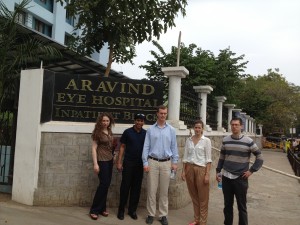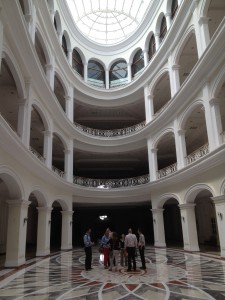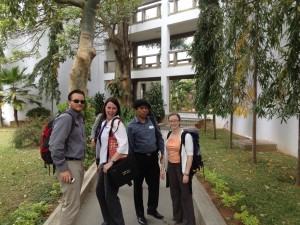“Is the world really flat?”
The thought of flying half way around the world to immerse myself in a culture so alien to that which I was accustomed to didn’t really seem real until the plane took off from YVR, leaving the Vancouver skyline slowly fading away behind me. With a hectic final week before leaving to go to India for Sauder’s first Global Immersion, I barely even had time to think about what I was going to bring with me, never mind consider what I really wanted to take away from the immersion experience or what I wanted to learn about the Indian economy and business environment. I therefore decided it was best to go with an open mind.
Bangalore – Part 1: Nine Stars & 2AdPro
Although we only spent a few days in Bangalore initially, they were tightly packed enough to ensure that we started our India immersion in full flow. The highlight of the first few days was a trip to listen to presentations from Nine Stars and 2AdPro. Both presentations provided interesting insights into how Indian IT companies initially leveraged their competitive advantage in being able to provide quality service for low prices but had now moved on to be innovators in their field, as well as providing quality service for low prices. Both presentations also provided interesting insights into the global ambitions and mindsets of two of India’s best and fastest growing IT companies. These companies compete on a global level, and are successful largely because of their innovative approaches and ability to adapt to a rapidly evolving marketplace.
Madurai: Aravind eye hospital & Aurolab
In visiting Madurai, we were exposed to two world-class operations, in Aravind eye hospital and its commercial arm, Aurolab. We were given tours of both the eye hospital and Aurolab, and although it was pleasant to relax and be guided around, we were all aware of the immediate and underlying purpose of the tours, namely to give us some real life context for our presentations to the Aurolab and Aravind boards on expanding both organizations’ reach within India and into Africa. That thought aside, what soon became obvious when touring both operations was that the Aurolab facility could have been located anywhere in the world and would not have looked out of place. With regard to Aravind eye hospital, although parts of the hospital, such as the waiting areas, where evident of a hospital in a developing nation, the process fundamentals of the hospital would surely be the envy of many Western hospitals. Following the tours, it was straight to an intense evening of group meetings and individual prep. As the next day dawned, most of us were already up and putting the finishing touches to our presentations after a long night. As we entered the meeting room that had been set aside for the presentations, we were greeted with expectant and keen looking expressions from the great and the good of Aurolab and Aravind. Each presentation was well received and probing questions were asked on subtle aspects of what was presented. After the intensity of the previous 24 hours, it was a welcome relief to spend some time enjoying the cultural offerings of Madurai.

Meenakshi Hindu Temple in Madurai

Enjoying the tour of Aravind Eye Hospital
Infosys – Mysore
The Infosys campus in Mysore was surely the most impressive corporate campus I have ever seen, more like a 5* resort than a corporate campus. The buildings, grounds and even the roads were immaculately clean (as well they should be with an army of grounds people patrolling the campus) and the hospitality provided to us was first class.

The impressive interior of one of
Infosys’ learning centre’s
Following the tour of the campus, we listened to 2 presentations from senior Infosys employees. It was during these presentations that I realized that although Infosys can compete with the biggest and best companies in the world in terms of quality of IT services provided, they are still some way behind their Western and perhaps Asian counterparts in terms of the quality of their presentations to an audience. Both presentations were quite poorly delivered and were surely not a fair reflection of what Infosys wanted us to take away from our tour. Indeed if such presentations were delivered to potential clients, Infosys would surely not win much business. Nevertheless, visiting Infosys was a very good lesson in demonstrating that anything the US can achieve in terms of producing companies like Google and Microsoft, so too can India in Infosys.

5* resort or corporate campus??
Bangalore – part 2: Akshaya Patra
Of all the organizations we visited, the one I was most impressed with was Akshaya Patra. Akshaya Patra is an NGO registered in Bangalore. It provides healthy mid-day meals to 1.3 million children studying in Government schools and Government-aided schools. It is the world’s largest NGO-run Mid-day meal program. In addition to the outstanding work it is doing in helping to alleviate child hunger in poor Indian communities, Akshaya Patra is a marvel in process driven operational efficiency. As with 2AdPro and NineStars, here is another example of an Indian company that can produce high quality products (healthy meals) for a low cost. There is no doubt that given the passion of those involved with Akshaya Patra, combined with its operational efficiency and focus on lean process management, it is only a matter of time before even greater strides will be made towards eliminating childhood hunger in India. Moreover, it is clear that Western countries are taking note of Akshaya Patra’s success, as members of a number of top US business schools are regular visitors to the NGO’s facilities and a Harvard Business School case study has been written about the company.
Ultimately, seeing organizations such as 2AdPro, Aurolab, Infosys and Akshaya Patra clearly demonstrated to me that developments in the global economic landscape have leveled the playing field in terms of opportunities for competitors to engage with commerce or to use modern business practices to alleviate societal problems. Despite the impressive nature of these companies however, there is still much of India that suggests that there is more development required in the country’s economic landscape before the world can be considered flat.
Working with some of India’s future business leaders
One of the highlights of our immersion experience in India, was to work with students from India’s leading business school, IIM-B on a childhood malnutrition case.
Working with such obviously intelligent, motivated and hard working people was a great learning experience, in particular it was fascinating to see a snapshot of the work ethic which India’s future business leaders will put into practice to help further fuel the growth of the Indian economy. Despite the intelligence and hard working nature of the IIM-B students, their youth betrayed them in that they did not demonstrate the leadership skills or the creativity that someone with more worldly and business experience would have demonstrated. Indeed in most instances the general dynamic of our team was such the IIM-B students carried out much of the core research, and the Sauder MBA’s as well as the Deloitte representative decided upon the structure of our presentation and how best to relate our “story”. My key takeaway from this experience therefore was to realize how important it is to have real world business experience before embarking upon an advanced business degree. It was also confirmed to me, having worked with high performance teams at Sauder, that my leadership skills are such that I am able to guide the decision making process of a high performance team with differing skill sets, but that it is important to know how best to leverage the abilities of each team member.

A few members of team Sauder checking out the IIM-B grounds
Following my experience with the IIM-B students, I will look to make more use of team members’ skill sets so that each member can focus on what they are best at and what they enjoy the most so the team will perform better.





